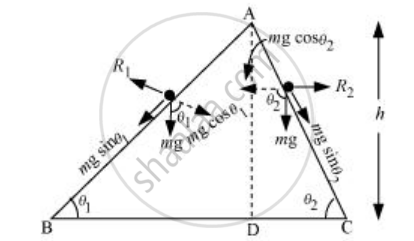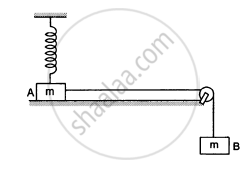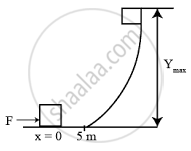Advertisements
Advertisements
Question
Two inclined frictionless tracks, one gradual and the other steep meet at A from where two stones are allowed to slide down from rest, one on each track . Will the stones reach the bottom at the same time? Will they reach there with the same speed? Explain. Given θ1 = 30°, θ2 = 60°, and h = 10 m, what are the speeds and times taken by the two stones?

Solution 1
The given situation can be shown as in the following figure:

AB and AC are two smooth planes inclined to the horizontal at ∠θ1 and ∠θ2 respectively. As height of both the planes is the same, therefore, noth the stones will reach the bottom with same speed.
As P.E. at O = K.E. at A = K.E. at B
∴ mgh = 1/2 mv12 = 1/2 mv22
∴ v1 = v2
As it is clear from fig. above, accleration of the two blocks are a1 = g sin θ1 and a2 = g sin θ2
As θ2 > θ1
∴ a2 > a1
From v = u + at = 0 + at
or, t = v/a
As t ∝ 1/a, and a2 > a1
∴ t2 < t1
i.e., Second stone will take lesser time and reach the bottom earlier than the first stone.
Solution 2
1/2mv^2 = mgh, v = `sqrt(2gh)`
`=sqrt(2xx10xx10) ms^(-1) = 14.14 ms^(-1)`
`v_B = v_C = 14.14 ms^(-1), l = 1/2(g sin theta) t^2`
`sin theta = h/l , l = h/(sin theta)`
`h/sin theta = 1/2 g sin theta t^2` or `t =sqrt(2h/g).1/(sin theta)`
`t_B = sqrt((2xx10)/10). "" 1/sin 30^@ = 2sqrt2s`
`t_C = sqrt(2xx10)/10 . 1/sin 60^@ = (2sqrt2)/sqrt(3) s.`
APPEARS IN
RELATED QUESTIONS
A particle is rotated in a vertical circle by connecting it to a string of length l and keeping the other end of the string fixed. The minimum speed of the particle when the string is horizontal for which the particle will complete the circle is
You lift a suitcase from the floor and keep it on a table. The work done by you on the suitcase does not depend on
(a) the path taken by the suitcase
(b) the time taken by you in doing so
(c) the weight of the suitcase
(d) your weight
A block of mass m is attached to two unstretched springs of spring constants k1 and k2 as shown in the following figure. The block is displaced towards the right through a distance x and is released. Find the speed of the block as it passes through the mean position shown.

In the following figure shows two blocks A and B, each of mass of 320 g connected by a light string passing over a smooth light pulley. The horizontal surface on which the block Acan slide is smooth. Block A is attached to a spring of spring constant 40 N/m whose other end is fixed to a support 40 cm above the horizontal surface. Initially, the spring is vertical and unstretched when the system is released to move. Find the velocity of the block A at the instant it breaks off the surface below it. Take g = 10 m/s2.

A spring of negligible mass and force constant 5 Nm–1 is compressed by a distance x = 5 cm. A block of mass 200 g is free to leave the end of the spring. If the system is released, what will be the speed of the block when it leaves the spring?
Which of the diagrams shown in figure represents variation of total mechanical energy of a pendulum oscillating in air as function of time?
Why is electrical power required at all when the elevator is descending? Why should there be a limit on the number of passengers in this case?
A body falls towards earth in air. Will its total mechanical energy be conserved during the fall? Justify.
A bob of mass m suspended by a light string of length L is whirled into a vertical circle as shown in figure. What will be the trajectory of the particle if the string is cut at
- Point B?
- Point C?
- Point X?

A force shown in the F-x graph is applied to a 5 kg cart, which then coasts up a ramp as shown. The maximum height, ymax is ______ m, at which the cart can reach.
(g = 10 m/s2)


